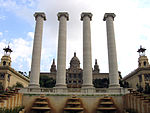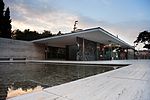Magic Fountain of Montjuïc
1929 Barcelona International ExpositionArchitecture of BarcelonaBarcelonaBuildings and structures completed in 1929Buildings and structures in Barcelona ... and 5 more
CataloniaFountains in BarcelonaSants-MontjuïcTourist attractions in BarcelonaWorld's fair architecture in Barcelona

The Magic Fountain of Montjuïc (Catalan: Font màgica de Montjuïc, Spanish: Fuente mágica de Montjuic) is a fountain located at the head of Avinguda Maria Cristina in the Montjuïc neighborhood of Barcelona, Catalonia, Spain. The fountain is situated below the Palau Nacional on the Montjuïc mountain and near the Plaça d'Espanya and Poble Espanyol de Barcelona. The fountain, like most of the surrounding developments, was constructed for the 1929 Barcelona International Exposition.The fountain sprays 700 gallons of water a second through 3620 jets to create its effect. The highest water spout is 170 feet.
Excerpt from the Wikipedia article Magic Fountain of Montjuïc (License: CC BY-SA 3.0, Authors, Images).Magic Fountain of Montjuïc
Plaça de Carles Buïgas, Barcelona
Geographical coordinates (GPS) Address External links Nearby Places Show on map
Geographical coordinates (GPS)
| Latitude | Longitude |
|---|---|
| N 41.371152777778 ° | E 2.1517361111111 ° |
Address
Font Màgica de Montjuïc
Plaça de Carles Buïgas
08001 Barcelona
Catalonia, Spain
Open on Google Maps











